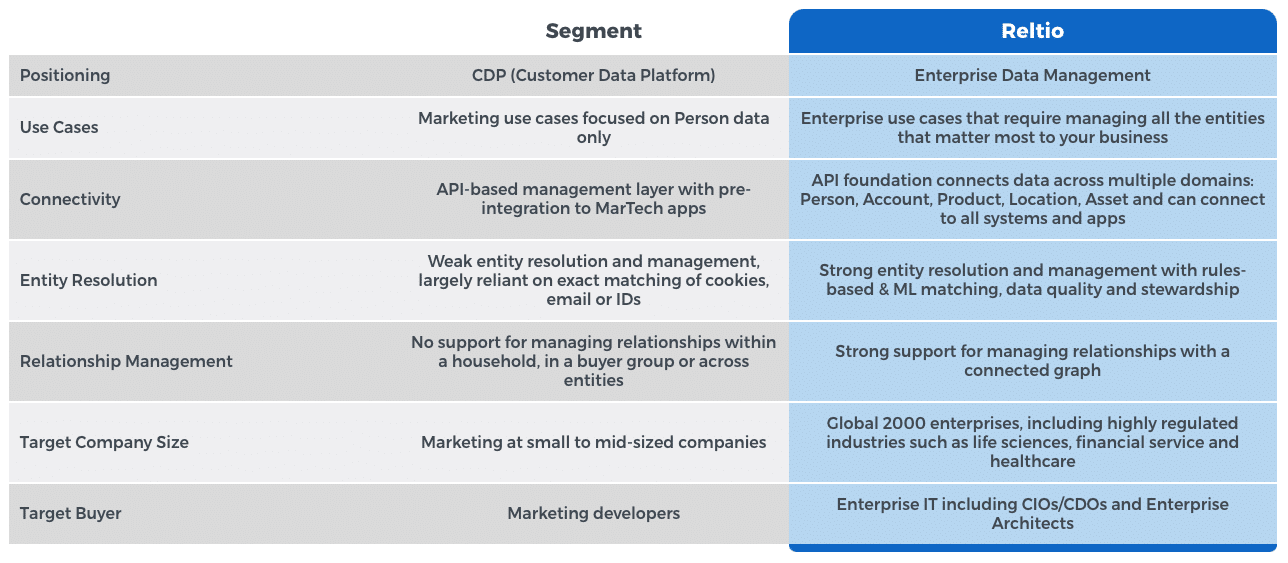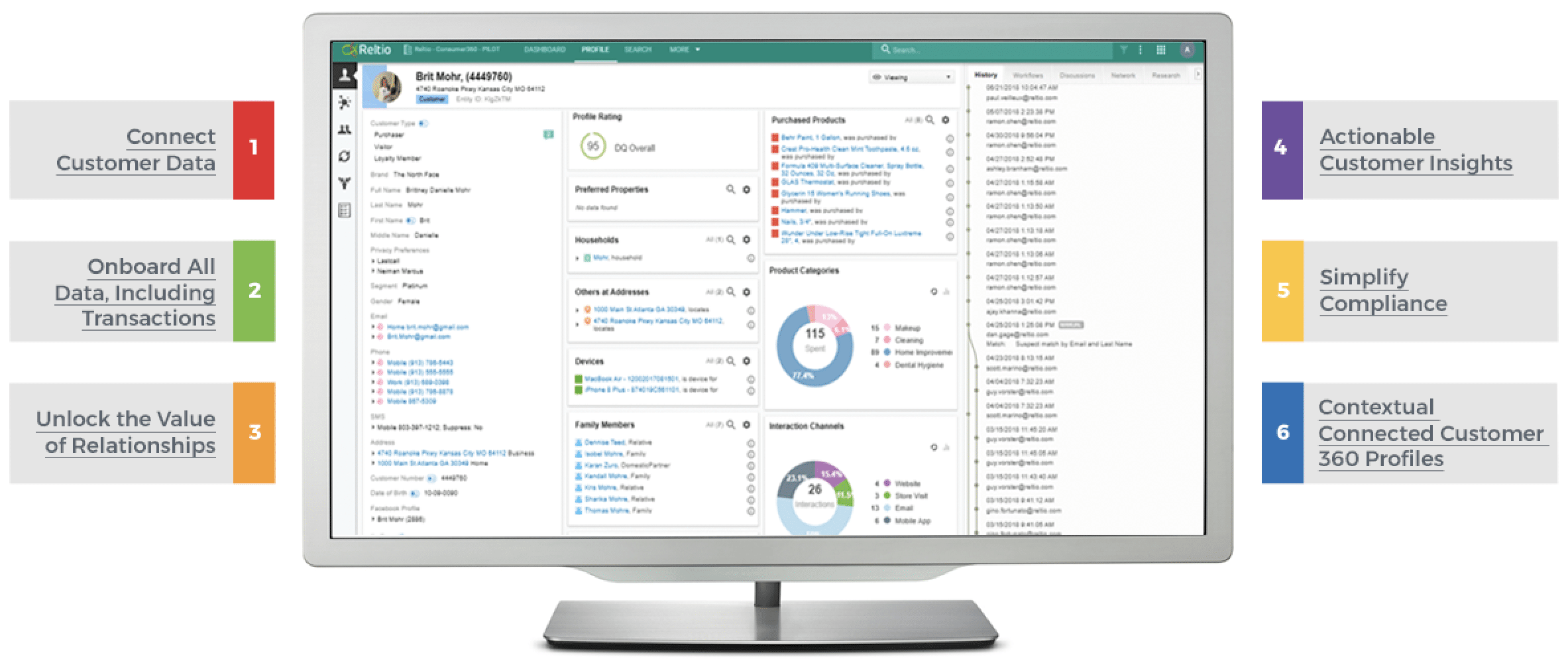Why Twilio’s $3.2B Acquisition of Segment May Not Be Enough

POV on Twilio’s $3.2B Acquisition of Segment
- Twilio as an acquirer is not a surprise because Twilio is positioned as a Customer Engagement Platform for voice and messaging but did not have any coverage for data. Segment is a Customer Data Platform (CDP) player that focuses exclusively on person data. Its target audience are marketing developers who value Segment’s list of pre-integrated systems. The premium valuation at $3.2B shows how in demand data management technology is as a foundation for connected customer experiences. While Segment has done really well in the SMB market segments, they don’t have a track record selling to Global 2000 enterprise customers.
POV on the Customer Data Platform Market
- The customer data platform vendor landscape has exploded in recent years. These vendors target CMO budgets. However, it’s become very confusing for buyers because vendors claim varying capabilities across the data management technology and activation spectrum.
-
- <!– li style=”font-weight: 400;”>Gartner published a report to help address the confusion:
Gartner: Choose Between CDP and MDM Solutions for 360-Degree Customer Insights
- </li –>
- Reltio’s goal is to provide clarity, educate the market and explain our differentiation. We published an eBook, 10 Questions to Ask Before Considering a Customer Data Platform.
-
- While many customer data platforms have strong activation capabilities, many CDPs have only basic identity resolution capabilities that rely on email addresses and cookies, (which are being phased out) and will continue to be marginalized.
- We believe the Segment acquisition by Twilio and the “death of the cookie” heralds an earlier start to the CDP market consolidation that Gartner predicted for 2023. This accelerates the rise of first-party data as a unique, invaluable and differentiating asset and validates that the gold rush for data platforms is just starting. Every large software player and especially the up-and-coming ones will want to own a data platform.
What’s left unsolved in Twilio’s customer engagement platform approach?
Twilio will have the same 3 gaps that all the other large vendors like Adobe, Salesforce, Oracle and SAP have in their application stacks.
1) IDENTITY RESOLUTION
Why using cookies and IDs for identity resolution is not good enough
The ability to resolve identities to stitch customer 360 together is mission-critical in the connected world. Identity resolution shouldn’t be based just on cookies. It should be based on multiple data points or attributes that are available in a connected data platform that manages first-party data.
Here are the common problems that might not be detected:
-
- People use different email addresses based on purpose and context.
- People’s names spelled differently: Are Robert Smith and Bob Smith one person or two different people?
- Company names spelled differently would also cause issues: Are Coke and Coca-Cola one company or two different companies?
Why using just email address for identity resolution is not good enough
A quick-fix solution is to use an email address as the basis for entity resolution. But that’s not good enough if you’re trying to deliver connected customer experiences across the customer journey that includes digital and human interactions. For example, while email addresses are helpful for marketing teams who communicate largely through this channel, email addresses are not the de facto starting point for human connection, which salespeople, relationship managers, store associates, call center reps, loyalty teams or delivery teams care about.
Let’s take a common banking example, people use different email addresses for different purposes. I use my Gmail account to engage with my bank as a consumer. I use my company email to engage with my bank as a commercial customer. But I may be reaching out on behalf of my spouse, who is also a retail banking and commercial customer. I am one person, but I may be using different email addresses and have different needs based on my role in any interaction. Because of this, banks often fail to understand the full relationship they have with customers. But the same holds true for other industries like telco, insurance, CPG, retail and life sciences.
The more data points or “attributes” you have for resolving the identity of a person, the more you can trust it’s accuracy.
2) ENRICHMENT
Why focusing only on 3rd party data enrichment is a limitation
It’s a common practice across industries to use third-party data to enrich person data. It’s used to gain a deeper and richer understanding of customers. Without enrichment, it’s difficult to segment customers and personalize engagement. Most companies use third-party demographic information to enrich their customer data. Some enrich with third-party lifestyle information. Companies that sell to businesses enrich their data with firmographic information. However, innovative companies are now enriching their data with psychographic information. It can come from third-party data, but it can also come from first-party data, which is unique to a particular business. It comes from an understanding of customer transactions and interactions, which makes it much more valuable and insightful.
If you can capitalize on your own first-party psychographic data gleaned from transactions and interactions, you can use it to create a highly differentiated experience.
3) RELATIONSHIPS MATTER
Why focusing exclusively on person data is a limitation
Let’s go back to the banking example I shared earlier. My bank wants to know if I am reaching out for a personal need or on behalf of someone in my household. Am I reaching out as a consumer or my commercial banking relationship? My bank wants to understand my full relationship across my roles. They want to engage with me in the right context. So this is the bigger, more complex data challenge that Twilio and others will not be able to solve with a CDP. Focusing exclusively on person data is a limiting factor.
Let’s take another example, Twilio’s acquisition of Segment. Twilio’s goal will be to accelerate the value of their acquisition by understanding the overlap between Twilio’s customer accounts and Segment’s customer accounts. But, they will not be able to use their newly acquired customer data platform to understand the overlap of their customer accounts with Segment’s. Why not? Well, that’s because Segment handles only person data. Their platform wasn’t designed to manage multiple domains or entities and to go beyond person identity resolution to do full entity resolution or matching on accounts or organizations. In fact, for any organization that is planning a merger, acquisition, or divestiture, it’s mission critical to get fast time to value. They need to be ready for this important integration step and use their identity platform to quickly and easily assess the overlap in customer accounts.
This really is the holy grail for data-driven businesses. That’s an important point. It’s not enough to have a data-driven marketing function. The accelerated shift to digital is forcing all functions to be data-driven, including sales, service, ecommerce, loyalty, digital, product and finance. This connected data can then serve multiple important outcomes. It becomes the trusted data that is delivered to applications and systems in real-time providing contextual views of information across digital and human experiences. It is also the insight-ready data used for business intelligence (BI), data science and analytics.
The developers and partners that are leveraging Segment today understand the value of real-time person data for data-driven marketing. I bet they have all felt the limitations of only having access to person data with limited exact id matching that leaves room for a tonne of duplicates or the lack of support for other mission-critical entities like accounts or organizations, products and locations. These developers have the opportunity to elevate their value at an enterprise-level to support their data-driven transformation by using a platform that delivers real-time data about entities and the relationships between them to the marketing team and across the enterprise.
To gain visibility into the full relationship a person has with a brand and all their roles as a consumer and as a business contact, it’s important to have a platform that resolves all the entities that matter most to your business.
This is where Reltio excels. Reltio’s blue chip customer base relies on our connected data platform to power multiple business outcomes. The platform powers their business operations, not only for person data, but other entities, including Account / Organization (B2B), Product, Location, Asset and connects these data sets together on the Connected Data Platform. Since this shift to digital has accelerated, we’re seeing a spike in demand from Global 2000 companies that need to resolve all the entities that matter most to their business.
Twilio’s $3.2B acquisition is a tremendous outcome for Segment, and for the industry as a whole. However our customers rely on us to support their multi-billion dollar businesses, and only focusing on person data would never be enough.
Quick Comparison Chart


